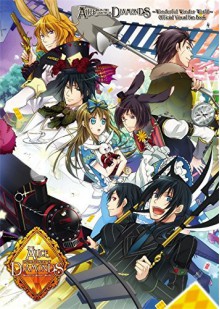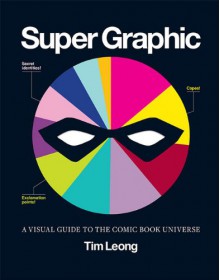
For such a skinny volume, this was jam-packed with stuff. I'll be going over each section individually. First, the more general stuff:
This book was lovely, and I liked a lot of things about it, but as an English-language release it had problems. The biggest one was that, as far as I can tell, none of the games are currently available in English, and this was clearly written for people with access to Alice in the Country of Diamonds: Wonderful Wonder World. Several sections were either useless or overly confusing without the game.
Although my experience with the franchise is limited to the English-language translations of the manga (which I still haven't completely finished reading) and the Alice in the Country of Diamonds light novel, I still got a lot out of this book. I'm not clamoring to own a copy of my very own (I checked this out via interlibrary loan), but I'm glad I requested it and got to read it.
I would like to mention one thing, though. I've seen this tagged as an artbook, and I'd hesitate to call it that. The artwork is a big reason for English-language folks to buy this, but the only section that's really devoted to the game's artwork is the "Illustration Gallery." That section has nice, large images, even when they're not full-page. Every other section has images that are maybe 1-4 inches wide. It's sort of a combination artbook, game guide, and promotional extras collection.
Now for the various sections.
About the Alice Series:
Helpful if your knowledge of the franchise is spotty or rusty, although I'd highly recommend that newbies to the franchise at least try some of the manga before picking this book up. It's a fan book, after all.
Mostly information I already knew. This section did give me a little more of the Alice in the Country of Diamonds context than the one light novel gave me, though, so that was nice.
Illustration Gallery:
Lots of full-color and often full-page illustrations and promotional art, with occasional comments from Mamenosuke Fujimaru, the artist. I loved this section, even though the artwork for this series tends to be busier than I'd like. It made me appreciate the book's larger page measurements.
Character Introductions:
Character introductions for everyone you might possibly meet in the game. The more important characters each got two pages with a brief description, a couple full-body illustrations, smaller facial expression illustrations, a brief profile, sample illustrations from the game, and a comment from Mamenosuke Fujimaru, the artist. Peter and Alice's sister got a page of info each (full-body illustration, facial expressions, description), while the Faceless characters only got a single page for all of them combined.
These introductions were nice, especially since I didn't get to see many of the new characters in the Alice in the Country of Diamonds light novel. However, they got a bit boring after a while. I was struck by how little variation there was between some of the facial expressions. For example, the only difference between Blood's “Cold 01” expression and his “Shy 01” expression was that the “shy” expression had a very slight blush and the “cold” expression had a slightly open mouth.
One amusing thing I noticed: the game's creators went to a lot of effort to keep most of Alice's potential love interests from being over 30. Wonderland math apparently does not work the same as real world math. For example, Ace is listed as being 12-14 years old as a child and 23-26 as an adult. Julius is 24-27 years old when taking care of child Ace, which means he should at least be 35-38 - maybe 33-36 at the youngest. Instead, he's 27-30 when Ace is an adult. The only character in the whole game who was allowed to be over 30 was Jericho Bermuda.
Character Routes:
These pages were a jumble of screenshots and words in various fonts and colors. It was overwhelming, to be honest. They gave me a sense of the different kinds of endings available for each character, but without access to the game for comparison, they were too confusing to really enjoy.
Something that shocked me: Alice is actually killed in one of the Twins' endings. I couldn't tell if it was because they killed her or because they didn't care enough about her to try to protect her during a shootout. Also, one of Sidney's endings had her being imprisoned by him, which reminded me uncomfortably of Toma's route in Amnesia.
Territories:
All kinds of background illustrations for the various territories featured in the game. Unfortunately, they were all very small – as many as 12 background illustrations per page. I'd have preferred at least a few full-page illustrations.
Interview & Commentary:
A short interview with Mamenosuke Fujimaru, and a short commentary written by Kou Satsuki, the scriptwriter. A few tidbits of info here and there, but otherwise “meh.” I did like that Fujimaru actually named favorite characters when asked to do so, rather than prevaricating.
Perfect Capture Guide:
This section would have been wonderful for anyone with access to the game. It included pages and pages of choices, the lines preceding the choices, and info about the effects those choices would have.
Anyone who just wants to know how to get to a particular ending in the game would love this section. As someone who doesn't have access to the game, I skipped it.
Exclusive Comics:
After the “Perfect Capture Guide” section, the book had to be flipped over in order to read the manga parts from right to left. The exclusive comics appeared to be continuations of a couple different endings from the game, the Twins' “Dead End” and Sidney's “Best End.”
The Sidney one was okay. Alice worried that Crysta would be a better fit for Sidney, and Sidney reassured her and told her a little about how he and Crysta first met.
The Twins' one was a continuation of that ending I mentioned, the one where Alice ended up getting killed. From what I could tell, her “death” transported her to another Wonderland, one where the Twins once again didn't remember her. She had some trust issues and doubted their willingness to protect her, due to them having let her die in the other Wonderland, but they seemed to have vague memories of liking her.
One thing I really liked: the pages were much larger than I was used to Alice in the Country pages being, and the artwork was pretty and crisp.
Previously Published Comics:
This section was fabulous. It started with some full-page gags and then morphed into four-panel comics. I thought it'd be boring, because a large number of the comics were focused on summarizing the franchise for those who were unfamiliar with it, and the remaining ones were devoted to explaining Alice in the Country of Diamonds. However, these all turned out to be much funnier than I expected. And also heavier on the fanservice and fanservice-related jokes – my favorites were probably the bit with Crysta (oh come on, one yuri route wouldn't hurt) and the bit with the twins (“The voice acting is incredible. The panting is very realistic and sexy.” (116) My laugh took me by surprise and I nearly choked on my tea).
(Original review posted on A Library Girl's Familiar Diversions.)

 Log in with Facebook
Log in with Facebook 









